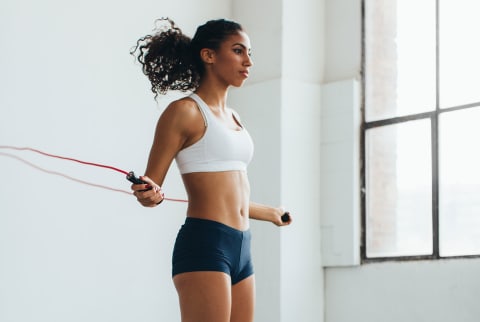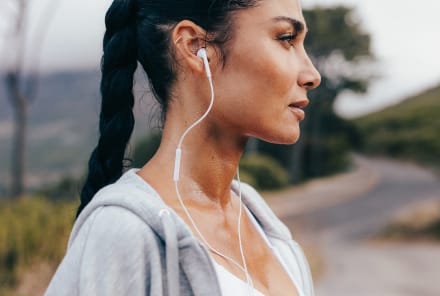Advertisement
Is Jumping Good Or Bad For Bone Health? I Asked The Experts


Osteoporosis disproportionately affects women, and not just by a little—a shocking 80% of all Americans with osteoporosis are women. Knowing this, it's safe to say that everyone, especially women, should give their bones some love.
You may assume this means taking the path of least impact—but as it turns out, that's not necessarily the case. In fact, incorporating one high-impact activity in your workout routine may be just the thing for osteoporosis prevention. We're talking about jumping.
Why jumping is good for bone health
According to double board-certified orthopedic sports medicine surgeon Vonda Wright, M.D., M.S., the answer is straightforward: "Research has shown that the impact of as few as 20 jumps a day can stimulate bone remodeling and mineralization1, period." Which Wright deems, "great for preventing osteoporosis."
Now, jumping for bone health isn't just about building bone but also rebuilding—so don't think it's too late to start. Wright uses the NASA astronauts as an example of this, noting that they often take part in trampoline exercises to build back their bone quality.
Plus, jumping can help to regain physical power and boost reaction time—two factors that tend to decrease with age, says physical trainer and Peloton instructor Marcel Dinkins.
Why women are more at risk
This is especially important information for women who, as mentioned previously, are at a higher risk of both developing osteoporosis and having fractures2 once they get that diagnosis. As for why, there are a few reasons.
First, Wright explains, "Men have higher levels of testosterone across their life span, which is important for building bone3."
However, estrogen is also beneficial for bone health. The problem here is that estrogen depletes naturally with age, especially once perimenopause and menopause hit. Because of this, Wright says women lose between 2% and 3% of their bone density per year in the perimenopause period4—illustrating just how essential estrogen is in supporting bone health.
Women tend to have smaller bones than men as well, which is another possible reason they experience higher rates of osteoporosis and fractures.
But hormones and body size are far from the only risk factors for osteoporosis5—others include nutrient deficiencies (especially vitamin D and calcium intake), family history, smoking, certain medications, and so on.
A note for young female athletes
3 exercises to try
Jumping is a worthwhile form of movement for most folks—but you shouldn't go from 0 to 100 if you're new to it. "The most common mistake is doing too much too soon," Dinkins says, so consider starting with beginner workouts and moving your way up. Below, three jumping workouts to try, in order of difficulty:
Beginners: Jump rope
"Start with the basics," Dinkins says, referring to a basic jump rope exercise.
"If you don't have a rope or haven't jumped rope before, use an 'air rope,' the same as you would an air guitar," she adds.
In action: Dinkins suggests aiming for time instead of reps. Jump rope for a full minute followed by a minimum of 90 seconds of rest between rounds. Do this for three rounds, and up your jumping time as you feel necessary.
Intermediate: Plyometric squat jumps
Squat jumps are one way to work your glutes, quads, and check jumping off your list in one fell swoop. Plus, they can spark a caloric burn due to the high intensity of the exercise, Dinkins says.
They're essentially just a squat, but at the top, you jump instead of simply straightening your legs. If you struggle with stability, consider starting with smaller jumps at first.
In action: Complete six to eight repetitions of squat jumps for two to three sets, resting in between sets.
Advanced: Box jumps
If you've already begun working jumps into your exercise routine, you may consider taking it to the next level with box jumps.
You can find a variety of heights at your local gym, or order them online. It's essential that you find a sturdy place to complete these exercises rather than jumping on a bench or another piece of equipment that isn't stable.
You should also start small here and work your way up to larger boxes once you feel ready.
In action: Complete three sets of six to eight reps, with adequate rest between sets. Before you commit to jumping on and off the box, consider only jumping onto it and then stepping down. This can help to prevent injuries when you're first starting out.
Who shouldn't add jumping exercises to their routine
Now, while jumping is beneficial for most people, especially regarding bone health, it's not recommended for everyone. Those with preexisting joint conditions or current severe bone health concerns should consult their physician before giving these exercises a go.
You should also know that jumping isn't the only way to support bone health when it comes to movement—strength training is another option. "As muscles pull on the bone, they generate enough stress on the bone that the bone will remodel," Wright explains.
So if jumping just isn't for you, give strength training a go—here are s the basics you need to know.
At the end of the day, it may seem like bone health is something to worry about 20, 30, or even 40 years from now. But, like many areas of well-being, the sooner you start intentionally caring for your bones, the less concerned you'll have to be in your older age. Consider it a favor to your future self.
The takeaway
Jumping exercises can help to remodel and mineralize bones, improving their integrity and creating a trickle-down effect that lands at osteoporosis prevention. Trainers recommend starting slow with jump rope and working your way up to something more advanced like box jumps. Here, more ways to support bone health as you age.
Watch Next
Enjoy some of our favorite clips from classes
Enjoy some of our favorite clips from classes
What Is Meditation?
Mindfulness/Spirituality | Light Watkins
Box Breathing
Mindfulness/Spirituality | Gwen Dittmar
What Breathwork Can Address
Mindfulness/Spirituality | Gwen Dittmar
The 8 Limbs of Yoga - What is Asana?
Yoga | Caley Alyssa
Two Standing Postures to Open Up Tight Hips
Yoga | Caley Alyssa
How Plants Can Optimize Athletic Performance
Nutrition | Rich Roll
What to Eat Before a Workout
Nutrition | Rich Roll
How Ayurveda Helps Us Navigate Modern Life
Nutrition | Sahara Rose
Messages About Love & Relationships
Love & Relationships | Esther Perel
Love Languages
Love & Relationships | Esther Perel
What Is Meditation?
Box Breathing
What Breathwork Can Address
The 8 Limbs of Yoga - What is Asana?
Two Standing Postures to Open Up Tight Hips
How Plants Can Optimize Athletic Performance
What to Eat Before a Workout
How Ayurveda Helps Us Navigate Modern Life
Messages About Love & Relationships
Love Languages
Advertisement

This Is The Real Reason You Look In The Mirror When You Cry, Experts Say
Jackie Newgent, RDN, CDN

Can Vitamin C Actually Shorten A Cold? What's Fact vs. Fiction
Molly Knudsen, M.S., RDN

This Is The Real Reason You Look In The Mirror When You Cry, Experts Say
Jackie Newgent, RDN, CDN

Can Vitamin C Actually Shorten A Cold? What's Fact vs. Fiction
Molly Knudsen, M.S., RDN

This Is The Real Reason You Look In The Mirror When You Cry, Experts Say
Jackie Newgent, RDN, CDN

Can Vitamin C Actually Shorten A Cold? What's Fact vs. Fiction
Molly Knudsen, M.S., RDN

The 8 Best Tests To Diagnose A Hormonal Disorder (That Most Docs Don't Order)
Romie Mushtaq, M.D., ABIHM

This Is The Real Reason You Look In The Mirror When You Cry, Experts Say
Jackie Newgent, RDN, CDN

Can Vitamin C Actually Shorten A Cold? What's Fact vs. Fiction
Molly Knudsen, M.S., RDN

The 8 Best Tests To Diagnose A Hormonal Disorder (That Most Docs Don't Order)
Romie Mushtaq, M.D., ABIHM













